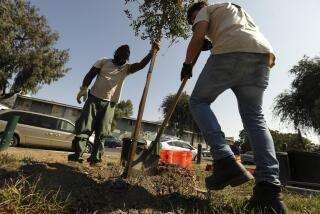Bears Take a Bite Out of Timber Firms’ Profits as Young Trees Become Lunch
EUREKA, Calif. — Timber companies here on California’s North Coast have seen their fortunes sink in an era of tight environmental regulations, foreign competition and tree-dwelling protesters. But the biggest threat of all may come from within the forests themselves: black bears that feed off the young trees.
The problem is not a new one; foresters have been battling it for decades. Yet the situation is getting worse, and timber producers say it’s because they are planting fast-growing trees that the bears find appetizing.
“We’re actually creating habitat for them,” said Steve Horner, a silviculturist, or forest scientist, with Pacific Lumber Co. “We’re creating salad bars for these bears.”
During late spring, when the animals are coming out of hibernation, they rip the bark off redwoods and Douglas firs, then scrape their teeth over the sweet cambium layer underneath.
The bears choose the young trees, those about 15 to 25 years old, because they taste sweet and their bark is easy to rip off, wildlife biologists say.
With the advent of large-scale logging, timber producers began creating vast areas of these young trees, thinned to encourage growth of the healthiest ones.
“You go into old-growth parks, or you go into other stands that are not being managed as aggressively, and you don’t see bear damage occurring in them,” said Greg Giusti, a forest advisor for the University of California Cooperative Extension in Ukiah.
“There’s a direct relationship between thinning activities -- trying to maximize growth on the trees -- and the behavioral response in the bears to begin feeding on the trees,” he said.
Giusti, who began studying the issue nearly 20 years ago, said bears probably don’t get much nutrition from the trees. It’s just that, in late spring, their other favorite foods, such as berries and acorns, are not available.
“They’re simply filling their bellies with wood fiber, trying to feel full,” Giusti said. “They have literally nothing else to eat.”
The effect on timber can be devastating. Sometimes a bear may only “taste” a tree, then move on. At other times, it will tear off the bark all the way around the trunk. Those trees die because the sap cannot travel up the trunk.
Even a single gouge in a tree can reduce its sales value because the wound can invite infestation or rot, Horner said.
Green Diamond Resource Co., formerly Simpson Resource Co., owns 450,000 acres of timberland in California, most of it in the northern counties of Humboldt and Del Norte.
A 26,000-acre area in Humboldt County known as the Little River watershed is the site of a pervasive bear problem that dates to at least the 1940s, according to news accounts of the time.
In some spots, “if you look closely, you can see damage on every other tree,” said Dan Opalach, timberlands investment manager for Green Diamond. “It’s really amazing.”
The destruction has been so severe on the 90,000-acre Hoopa Indian reservation that tribal officials have spent about $400,000 on bear research, including studying the effect of tree-stripping on bears’ teeth to see if the offending animals can be identified. The harvest of Douglas fir trees brings in about 90% of the tribe’s income.
In the past, timber companies tried exterminating the animals, and the state Department of Fish and Game authorized the hunting of bears outside the traditional fall hunting season for that purpose. But not all bears strip trees, so the problem animals couldn’t be specifically targeted. And after the public got wind of the practice in the 1980s, the resulting outcry put a virtual halt to it.
Washington state timber producers, also faced with ursine tree-munchers, have experimented with feeding them a specially designed food pellet. In California, however, state law prohibits the feeding of big game mammals.
Giusti said the Department of Fish and Game should make an exception to that rule for the bear problem.
“We’ve been stuck for 50 years, and all we’re doing is spinning our wheels,” he said. “We haven’t gotten anywhere with it because everyone has been reluctant to stick their necks out and try something.”
Fish and Game would “certainly be open” to a study proposal on the issue, said Karen Kovacs, a senior biologist supervisor with the department in Eureka.
Giusti also said the timber companies need to look seriously at changing how they manage their lands.
Opalach of Green Diamond agreed. “That’s one of the things we’re looking at,” he said. But nothing is likely to happen soon. “We have years left of study to do.”
More to Read
Sign up for Essential California
The most important California stories and recommendations in your inbox every morning.
You may occasionally receive promotional content from the Los Angeles Times.










